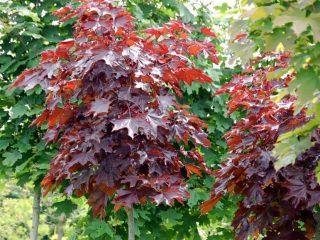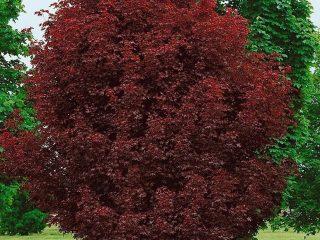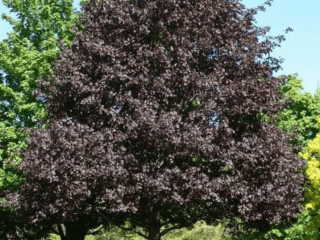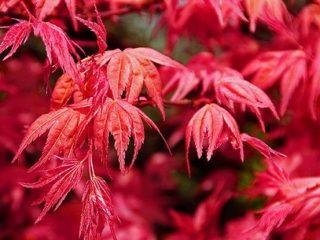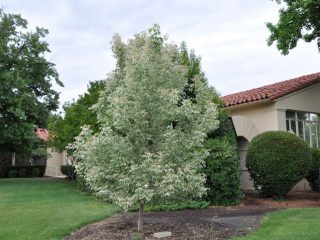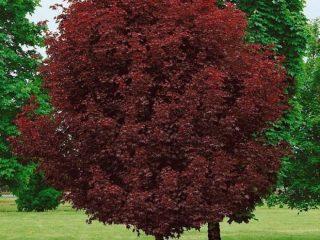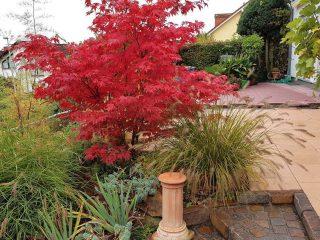Content
Tatarian maple is excellent for growing in urban environments. The tree has pronounced decorative qualities and is resistant to adverse environmental factors. The plant is often planted in parks and squares, on personal plots.

Tatarian maple grows well in difficult urban conditions and is tolerant of environmental pollution
Description of Tatarian maple
The Latin name of the tree Acer tataricum (Acer tataricum) is identical in lexical meaning to the Russian name “Tatar maple”. The popular decorative crop grows in most Russian regions. Heads of city services and owners of country houses value the plant for its unpretentiousness.
Another attractive quality of the tree is the rich color of large leaves and winged seeds. Due to the dark color of the bark, the Tatarian maple received a second name - black maple. Also, people often call the plant “non-maple” for the atypical shape of the leaf blades.
Tatarian maple sizes
Plants of this breed are small in size (up to 6 m). When growing freely, individual trees reach 9-12 m in height.
The shape of the crown of the Tatarian maple is spherical or ovoid, the width in diameter is 5 m, the gap from the ground to the deciduous canopy is approximately 1 m. In favorable conditions, the Tatarian maple lives up to 100 years or more.
Flowering Tatarian maple
Throughout the warm season, the Tatarian maple pleases the eye with its elegant appearance. In spring it is strewn with white and yellow panicle inflorescences. By summer, green winged fruits on long petioles form at the tips of the branches, which gradually turn pink, and by autumn they become bright red or orange. Volatile seeds consist of two symmetrical halves diverging at an acute angle.
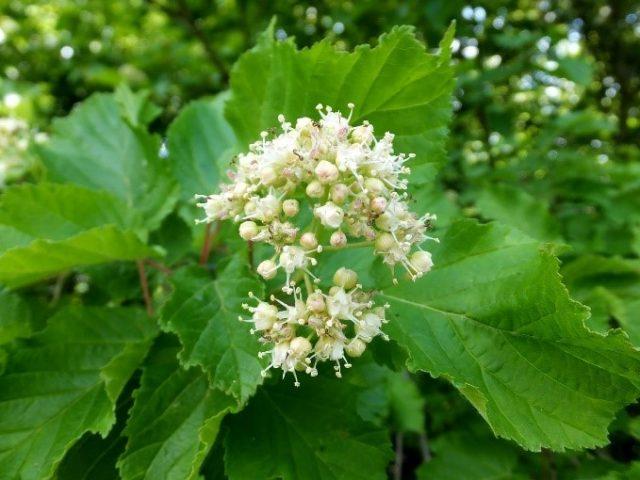
Tatarian maple is a honey plant, its fragrant flowers attract bees in early summer
Advantages and disadvantages
Tatarian maple exhibits drought resistance. The fact is that the root system of the Tatarian maple is highly branched, due to which the plant absorbs more moisture from the soil.

The undoubted advantage of the tree is its extensive crown, which forms a significant shadow area.
Pros:
- undemanding to soil structure and salinity level;
- withstands air pollution from chemicals and physical particles;
- does not react to sudden changes in temperature, survives severe frosts;
- develops well both in shady areas and in sunlit places;
- does not get sick and does not attract pests;
- gets along with other tree species without problems;
- has high decorative qualities;
- easily tolerates sanitary pruning and can be subjected to various moldings.
Minuses:
- it is impossible to control plant reproduction.
Classification of Tatarian maple
The plant acquired its second name “black maple” because of its bark. It is smooth and painted in a dark (almost black) color. Another name “non-maple” is explained by the shape of the tree’s leaves. Unlike other members of the Tatarian maple family, they are solid, oval, jagged along the edges.
Planting Tatarian maple
Tatarian maple seedlings can be purchased at nurseries. Before purchasing, they must be inspected for the absence (presence) of damage or rot. Compliance with the rules of agricultural technology is a necessary condition for planting a plant and successful adaptation to a new place.
Disembarkation dates
The best time to plant young plants is early spring, when the buds on the tree have not yet opened. In late autumn, after the leaves have fallen, planting work can also be carried out.
Landing location
The area where you plan to place the seedlings should be dry and well-lit. An important requirement for the territory: groundwater should not be located close to the surface. If moisture stagnates, it is necessary to organize a drainage system. Suitable for these purposes:
- pebbles;
- gravel;
- crushed stone;
- broken brick.
The thickness of the drainage layer is 15-20 cm. Excess water will not stagnate in the soil and cause damage to the root system of the tree.
Landing rules
For growing Tatarian maple, soil consisting of humus, turf and sand, taken in equal proportions, is suitable. The acidity of the earth should be in the range of 6.0-7.5. It is advisable to add 120-150 g of nitrate fertilizer, for example, nitroammophosphate, to depleted soil.
Landing algorithm:
- Make a hole 50-70 cm deep.
- Place the seedling in the hole without deepening the root neck.
- A tree trunk circle is formed.
- Water with settled water.
- Mulch the ground.
It is better to use peat as mulch. To deoxidize the soil, you can add pine needles, for alkalization - dolomite flour or lime. In the case of spring work, the soil is prepared in advance, in the previous autumn.
Features of care
Young trees need daily abundant watering. 20 liters of water are poured under each seedling. In the future, the number of waterings is reduced to once a week. It is enough to moisten adult specimens once a month, with the exception of dry summers.
To ensure that the plant's roots receive enough oxygen, the soil is thoroughly loosened. You can reduce moisture evaporation by organizing mulching. For 3-4 years, seedlings are fed with mineral compounds. In March and November, trees are subjected to sanitary pruning. The procedure involves the elimination of dry branches and damaged shoots.

Tatarian maple looks presentable if the crown is formed at the beginning of summer
Reproduction of Tatarian maple
Tatarian maple spreads well. Decorative crops are propagated in several ways:
- cuttings (green or woody);
- layering;
- shoots;
- seeds.
For vegetative propagation, lignified cuttings 25 cm long are prepared in the fall. They are dug in for the winter and planted in early spring.
Growing Tatarian maple from seeds involves their stratification. The seed is kept in a cold place for five months. Optimum temperature for seed hardening 0-5 0WITH.
Diseases and pests
Tatarian maple is resistant to pests and pathogens. The infection usually affects weakened plants. Trees may suffer from powdery mildew and black spot. Due to unfavorable weather conditions, Tatarian maple plantings are subject to invasion by insect pests:
- weevil;
- whiteflies;
- scaleworm;
- sawyer;
- aphids.
At the initial stage, folk remedies are used to combat fungi and parasites that have occupied tree plantations. If there is no result, modern biological and chemical substances are used.
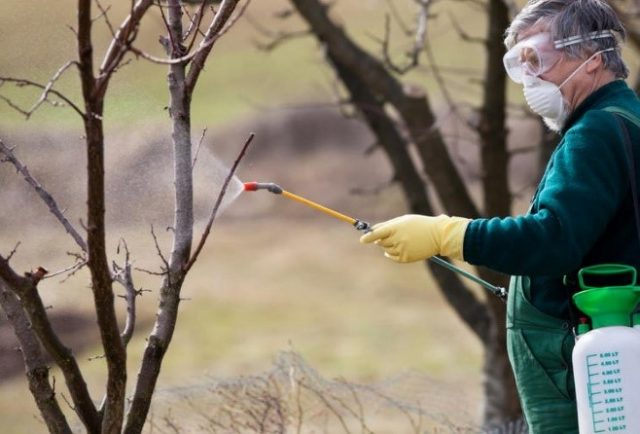
To prevent fungal diseases, trees are irrigated with copper sulfate in early spring.
Tatarian maple in landscape design
Urban landscapers are happy to use Tatarian maple when designing landscape areas.Low, spreading trees look great both in single and group plantings. All coniferous trees, as well as deciduous trees: birch, oak and linden, feel good next to maple. Thanks to the difference in texture and color of the leaves, it is possible to create catchy compositions. Black maple is a fertile material for decorative hedges. Plant fences turn out stylish and quite dense. In autumn, maple plantings are especially impressive with their golden-scarlet color.
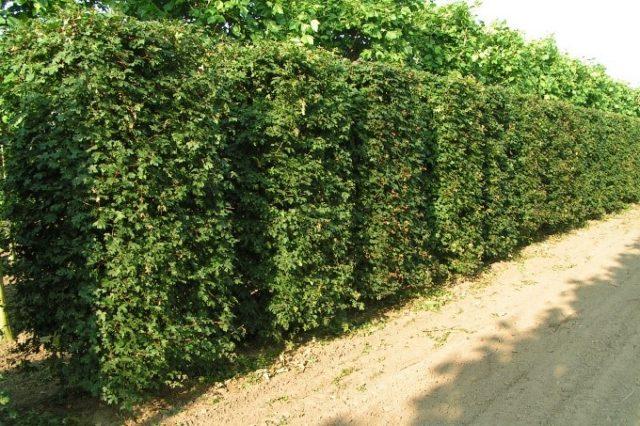
The homeowner, when forming a hedge, determines its optimal height.
Features of the appearance of this tree species are presented in the video:
Conclusion
Tatarian maple is not only a wonderful landscape plant intended for decorating city streets and garden plots. Large groups of unpretentious trees are used to protect residential areas from harmful emissions from enterprises, as well as agricultural plantings, especially in steppe climates.
